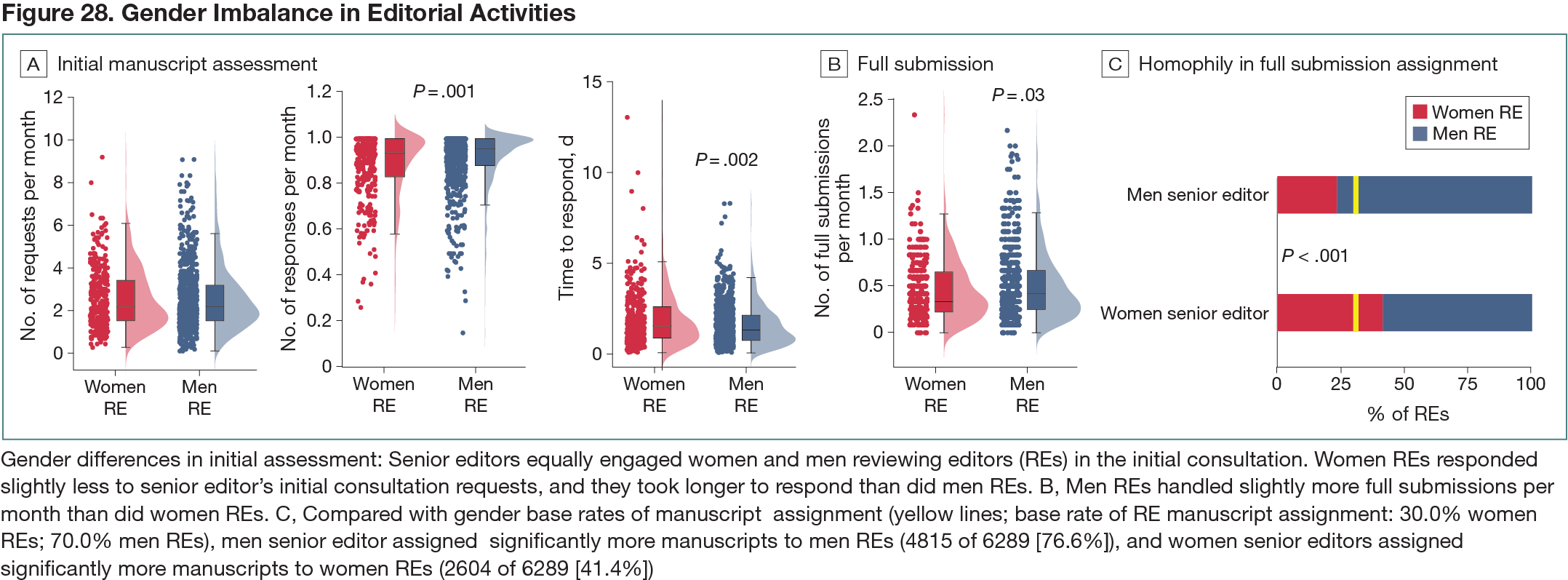Abstract
Assessment of Gender Balance in the Editorial Activities of a Researcher-Led Journal
Tal Seidel Malkinson,1 Devin B. Terhune,2 Mathew Kollamkulam,3 Maria J. Guerreiro,4 Dani S. Bassett,5,6,7,8,9,10 Tamar R. Makin3
Objective
Editorial decision-making is a fundamental element of the scientific enterprise, with critical implications for career advancement. Despite repeated calls for making deliberate efforts to incorporate gender diversity into editorial board structures, gender disproportions remain pervasive.1,2 Gender parity in the contributions to editorial decisions at various stages of the publication process was examined, based on analytics collected by the biomedical researcher–led journal eLife.
Design
Data accumulated by eLife’s platform from 2017 to 2019 were organized into 2 data sets. The reviewing editor (RE) data set included anonymous information on the engagement of individual REs (n = 1201) in the editorial process, with a binary gender assigned based on the editor’s name and gender expression. REs were consulted by senior editors at the initial assessment stage, and an RE was chosen to handle the full review process for the selected manuscripts. The manuscript data set included the outcome of submitted manuscripts (n = 24,056) in each submission stage, the assigned gender of the REs suggested by the authors, the assigned gender of the handling RE, and the assigned gender of the appointed senior editor. Owing to nonnormal distributions in the data, 2-tailed nonparametric tests were used, including (1) binomial tests and N − 1 χ² proportion comparison tests, (2) contingency table analysis, (3) a permutation-based Welch independent t test, and (4) equivalent bayesian analyses when significance was close to P < .05.
Results
Despite efforts to increase women representation, the board of REs was predominantly male (833 [69.4%]). Authors suggested fewer women as REs, even after correcting for men overrepresentation (29.08% women vs 30.6% men; χ²1 = 11.65; P = .001; Cohen h = 0.90). Although women editors were proportionally involved in the initial manuscript assessment (mean [SD] number of assessment requests per month, 2.40 [1.44] women REs vs 2.41 [1.51] men REs; t809.7 = 0.11; P = .92), they were underengaged in the full review process (mean [SD] number of full submissions per month, 0.40 [0.32] women REs vs 0.44 [0.37] men REs; t869.8 = 2.22; P = .03; Hedges g = 0.13). Gender homophily in manuscript assignment was found, such that senior editors overengaged same-gender REs (χ²1 = 224.55; P < .001; contingency coefficient of 0.186) (Figure 28). This tendency was stronger in more gender-balanced scientific disciplines (eg, in developmental biology, with 56.9% of manuscripts handled by men REs; r = −0.47; P = .05; Bayes factor10 = 1.77).
Conclusions
Together, the findings confirm that gender disparities exist along the editorial process and suggest that merely increasing the proportion of women members might not be sufficient to eliminate this bias.
References
1. Helmer M, Schottdorf M, Neef A, Battaglia D. Gender bias in scholarly peer review. eLife. 2017;6:e21718. doi:10.7554/eLife.21718
2. Palser ER, Lazerwitz M, Fotopoulou A. Gender and geographical disparity in editorial boards of journals in psychology and neuroscience. Nat Neurosci. 2022;25(3):272-279. Medline:35190729 doi:10.1038/s41593-022-01012-w
1Sorbonne Université, Institut du Cerveau–Paris Brain Institute–ICM, INSERM, CNRS, APHP, Hôpital de la Pitié Salpêtrière, Paris, France, tal.seidel@mail.huji.ac.il; 2Department of Psychology, Goldsmiths, University of London, London, UK; 3Institute of Cognitive Neuroscience, University College London, London, UK; 4eLife Sciences Publications Ltd, Cambridge, UK; 5Department of Bioengineering, University of Pennsylvania, Philadelphia, PA, USA; 6Department of Electrical & Systems Engineering, University of Pennsylvania, Philadelphia, PA, USA; 7Department of Physics & Astronomy, University of Pennsylvania, Philadelphia, PA, USA; 8Department of Neurology, University of Pennsylvania, Philadelphia, PA, USA; 9Department of Psychiatry, University of Pennsylvania, Philadelphia, PA, USA; 10Santa Fe Institute, Santa Fe, NM, USA
Conflict of Interest Disclosures
Tamar R. Makin is a senior editor for eLife. Maria J. Guerreiro is part of the executive staff team of eLife.
Funding/Support
Tal Seidel Malkinson was funded by Agence Nationale de la Recherche grant ANR-16-CE37-0005; Tamar R. Makin was funded by Wellcome Trust Senior Research Fellowship grant 215575/Z/19/Z and ERC Starting Grant 715022 EmbodiedTech.
Role of Funder/Sponsor
The funders had no role in the design and conduct of the study; collection, management, analysis, and interpretation of the data; preparation, review, or approval of the abstract; or decision to submit the abstract for presentation.
Additional Contributions
We thank the eLife editorial team for facilitating this study at all stages and, in particular, Andy Collings and Daniel Ecer for help with preparing the data set; Jennifer Raymond, Chris Baker, and Jon Roiser for discussions about the data set; and Michael B. Eisen, Tim Behrens, and eLife’s senior leadership for feedback and ongoing support of this study.
Additional Information
Maria J. Guerreiro is a co–corresponding author.

